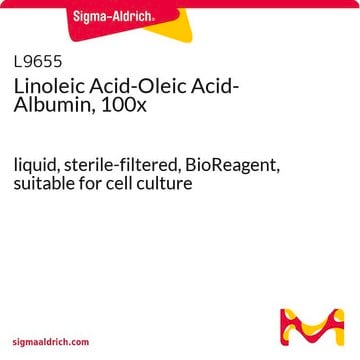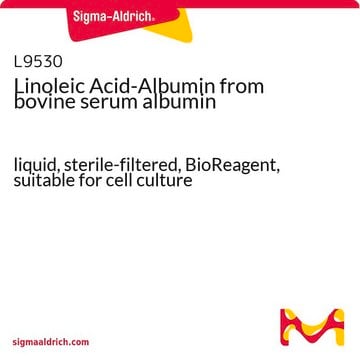The concentration of BSE in this product is approximately 100 mg/mL in DPBS. The lot-specific concentration is reported in the Certificate of Analysis as "Protein by Biuret". Please see the link below to review a sample or lot specific Certificate:
https://www.sigmaaldrich.com/product/sigma/o3008#product-documentation
O3008
Oleic Acid-Albumin from bovine serum
liquid, sterile-filtered, BioReagent, suitable for cell culture
Synonym(s):
Oleic acid-BSA complex
Select a Size
About This Item
Recommended Products
biological source
bovine
sterility
sterile-filtered
product line
BioReagent
form
liquid
composition
Oleic acid, 2 mol/mol albumin
concentration
100 mg/mL BSA in DPBS
90-120 mg/mL protein (biuret)
technique(s)
cell culture | mammalian: suitable
impurities
endotoxin, tested
storage temp.
2-8°C
Application
Biochem/physiol Actions
related product
Storage Class Code
10 - Combustible liquids
WGK
WGK 3
Flash Point(F)
Not applicable
Flash Point(C)
Not applicable
Personal Protective Equipment
Choose from one of the most recent versions:
Certificates of Analysis (COA)
Don't see the Right Version?
If you require a particular version, you can look up a specific certificate by the Lot or Batch number.
Already Own This Product?
Find documentation for the products that you have recently purchased in the Document Library.
Customers Also Viewed
Articles
Supplement cell culture systems with fatty acids for biomanufacturing heterologous proteins like monoclonal antibodies.
How the unsaturated fatty acid, oleic acid and other cell culture components affect the performance of serum-free, protein-free cell culture systems used for biomanufacturing heterologous proteins including monoclonal antibodies.
-
What is the bsa concentration in the solution?
1 answer-
Helpful?
-
-
Is it suitable to store this reagent in -20C in aliquots? We received our order recently and the shipping box has a large label of "Do not Freeze" I was inquiring if there was a decrease in concentration if frozen?
1 answer-
To effectively preserve the integrity of this product, it should be stored at the recommended temperature and protected from light. The stability and optimal performance may be impacted by the freeze/thaw process. This product should be stored at 2 to 8 C.
Helpful?
-
-
How is the binding of oleic acid to BSA is confirmed?
1 answer-
Many fatty acids have a natural affinity to some plasma proteins. In this case BSA serves as a carrier or transporter of the insoluble oleic acid. The product is tested for protein and oleic acid content, only. No additional testing is performed to confirm the complex formation. See the following publications for further information:
https://pubmed.ncbi.nlm.nih.gov/236351/
https://pubmed.ncbi.nlm.nih.gov/19745557/#:~:text=Albumin%20acts%20as%20main%20fatty,a%20several%20orders%20of%20magnitudeHelpful?
-
-
What is the concentration of Oleic Acid in this product in Molarity (M) or milimolarity (mM)? I need this to be able to follow a protocol
1 answer-
Oleic acid has a molecular mass of 282.47 g/mol. In order to find the concentration of oleic acid in a specific lot, use the Oleic acid concentration on the lot-specific certificate of analysis (COA).
The equation used to find the concentration is as follows: (molar mass of Oleic acid) x (concentration of Oleic acid from COA), this will result in units of liter/mole which can be multiplied by the reciprocal, resulting in units of Molarity (mole/liter).
For example, for lot number SLCM9550, the Oleic acid concentration is reported as 940 ug/mL.
282.47 g/mol / 0.94 g/L =300.5 L/mol
1/300.5= 0.003327 M (mol/liter) = 3.33 mM Oleic AcidHelpful?
-
-
Through what method is oleic acid complexed to BSA?
1 answer-
Unfortunately, the method of preparation considered proprietary.
Helpful?
-
Active Filters
Our team of scientists has experience in all areas of research including Life Science, Material Science, Chemical Synthesis, Chromatography, Analytical and many others.
Contact Technical Service







